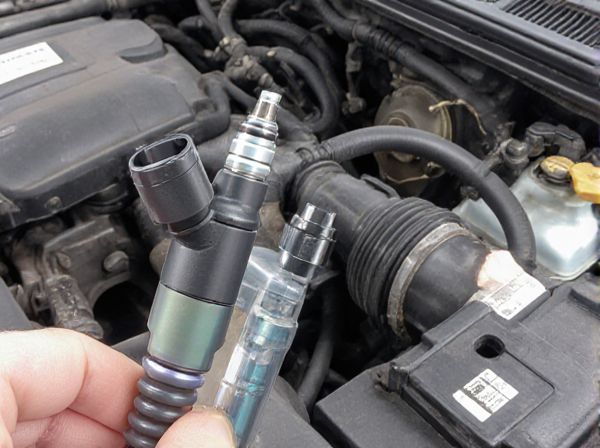
Photo illustration: Saturated vs Peak-and-hold
Saturated and peak-and-hold methods differ in signal processing applications, where saturation refers to limiting signal amplitude to a maximum level, preventing distortion. Peak-and-hold captures and maintains the highest signal value over a period, ensuring accurate measurement of transient peaks. Understanding the differences helps you select the optimal technique for signal analysis and control systems.
Table of Comparison
| Feature | Saturated Injector | Peak-and-Hold Injector |
|---|---|---|
| Operation | Constant full current during injection | High initial peak current, then lowered hold current |
| Energy Efficiency | Lower, higher continuous current consumption | Higher, reduced average current saves energy |
| Injector Response Time | Slower opening due to continuous current | Faster opening with peak current boost |
| Heat Generation | More heat due to sustained current | Less heat, cool operation by reducing hold current |
| Complexity | Simple driver design | Requires complex driver electronics |
| Application | Older fuel injection systems | Modern fuel injection systems for efficiency |
Understanding Fuel Injector Technologies
Saturated fuel injectors operate by fully opening the injector coil when energized, providing a continuous, steady fuel flow ideal for conventional engines, while peak-and-hold injectors use a high initial current to rapidly open the injector followed by a lower holding current to maintain it, enabling faster response and precise fuel delivery for performance applications. Understanding the differences between saturated and peak-and-hold technologies is crucial for optimizing fuel efficiency, engine responsiveness, and emissions control. Modern high-performance engines often prefer peak-and-hold injectors due to their ability to handle higher pulse frequencies and improved durability under demanding conditions.
What is Saturated Injector Operation?
Saturated injector operation refers to fuel injectors being driven fully open for a specific pulse duration, delivering a consistent and maximum fuel flow rate during injection. This mode ensures stable injector timing and predictable fuel quantity, ideal for many traditional fuel injection systems that use a fixed current to saturate the injector coil quickly. Saturated injectors contrast with peak-and-hold operation, where an initial high current rapidly opens the injector followed by a reduced hold current to maintain it, optimizing energy use and allowing finer control of injector opening times.
Defining Peak-and-Hold Injector Operation
Peak-and-hold injector operation controls fuel injectors by delivering an initial high current to quickly open the injector, followed by a reduced current to maintain the open state efficiently. Unlike saturated injector operation, which applies a constant current throughout the injector pulse, peak-and-hold minimizes heat generation and electrical load by varying current intensity. This precise current modulation enhances injector responsiveness and durability in modern fuel injection systems.
Key Differences: Saturated vs. Peak-and-Hold
Saturated displays maintain constant luminance by driving LEDs at maximum current, resulting in stable but less energy-efficient output, while peak-and-hold technology delivers short, high-intensity pulses followed by lower current holding, optimizing brightness with reduced power consumption. Peak-and-hold allows for improved dynamic range and sharper image quality by leveraging the temporal response of LEDs, contrasting with the continuous output of saturated systems. The key difference lies in power management and image rendering, where peak-and-hold offers enhanced efficiency and contrast compared to the consistently high drive currents of saturated displays.
Electrical Characteristics of Each System
Saturated systems operate with constant current flow, maintaining a fixed magnetic flux in the transformer core, which results in stable electrical characteristics and minimal signal distortion. Peak-and-hold systems detect and hold the peak value of the current, leading to variable magnetic flux and transient responses that can introduce non-linearities and affect accuracy. Electrical characteristics such as response time, hysteresis, and saturation levels differ significantly, with saturated systems offering improved linearity and peak-and-hold systems excelling in capturing transient peak currents.
Performance Impact on Engine Tuning
Saturated tuning limits fuel or ignition parameters to prevent engine knock but restricts performance potential by capping output gains. Peak-and-hold tuning maintains maximum injector or ignition duty cycle momentarily, allowing more aggressive fuel delivery and spark timing for improved power and throttle response. Optimizing between saturated and peak-and-hold strategies directly influences engine efficiency, power output, and tunability under dynamic driving conditions.
Compatibility with Modern ECU Systems
Saturated sensor outputs often cause signal distortion that can challenge modern ECU systems when precise data is crucial for engine control and diagnostics. Peak-and-hold sensors deliver more accurate and stable signals by capturing the maximum parameter values, enhancing compatibility with high-speed, real-time ECU data processing. This improved signal integrity enables advanced engine management features and optimal performance tuning in contemporary vehicles.
Pros and Cons: Saturated Injectors
Saturated injectors offer simplicity and cost-effectiveness due to their straightforward design and lower driving voltage requirements, making them suitable for older ECU systems. However, they tend to have slower response times and higher heat generation, which can limit performance and efficiency, especially at higher engine speeds. Their higher current draw also increases electrical load, potentially impacting overall vehicle electrical system reliability.
Pros and Cons: Peak-and-Hold Injectors
Peak-and-hold injectors provide faster response times and improved fuel atomization, enhancing engine performance and reducing emissions. These injectors require more complex wiring and a dedicated power supply, leading to increased installation cost and potential reliability issues. While they offer precise control at varying RPMs, peak-and-hold injectors may generate higher heat, necessitating effective thermal management.
Choosing the Right Injector for Your Application
Selecting the right fuel injector depends significantly on understanding the differences between saturated and peak-and-hold types. Saturated injectors operate at a steady current, ideal for reliability and simplicity in standard performance applications, while peak-and-hold injectors use a high initial current to quickly open the injector followed by a lower holding current, offering improved response and finer fuel control for high-performance or turbocharged engines. Evaluating factors such as engine demands, fuel requirements, and ECU compatibility ensures optimal injector choice for efficiency and power output.
 caratoz.com
caratoz.com